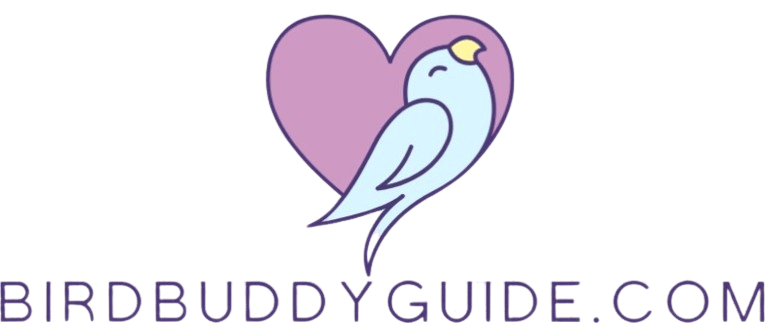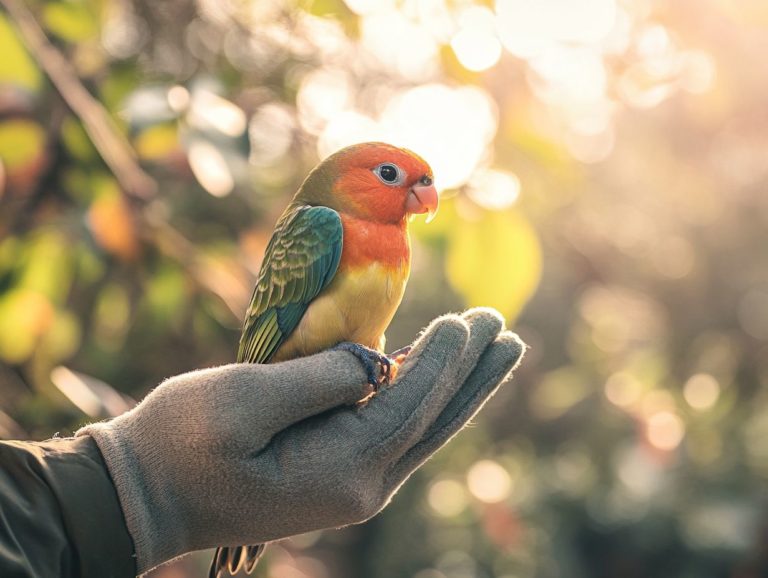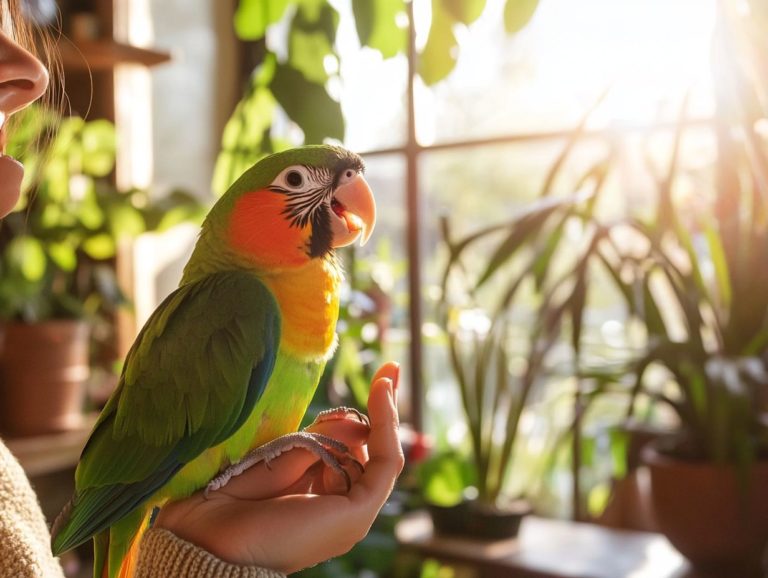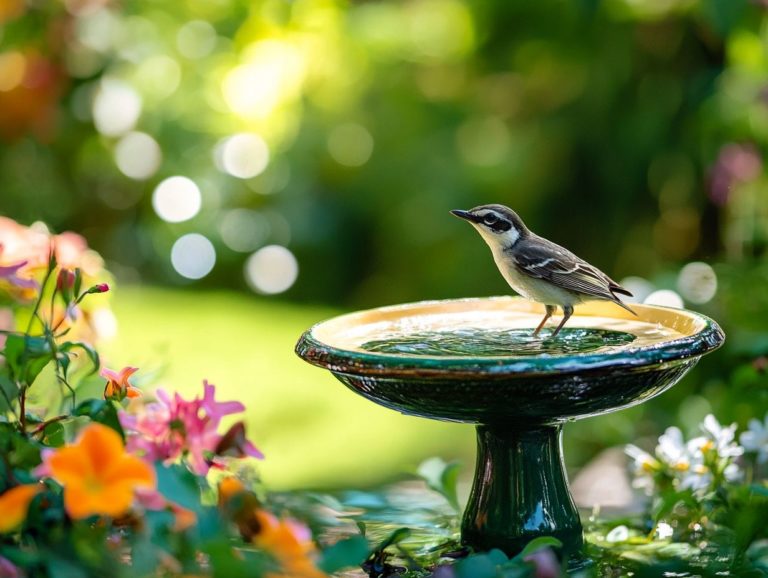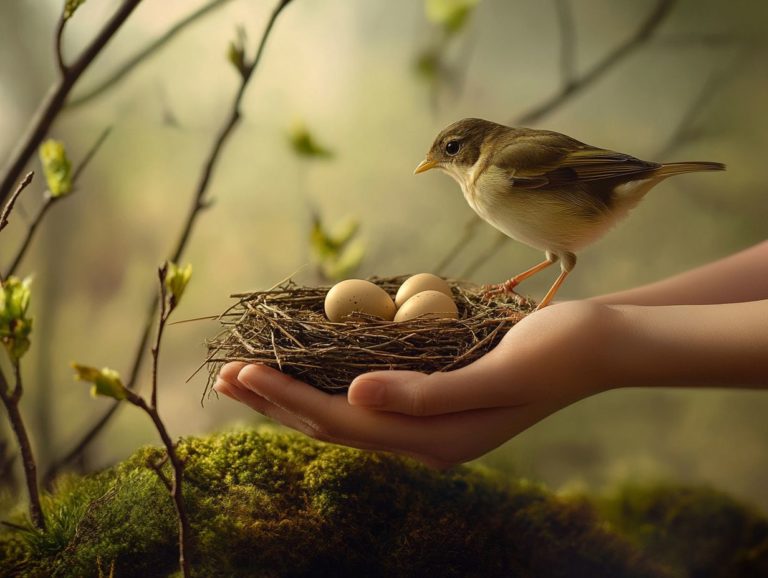How Do I Train My Bird to Talk?
Bird sounds are a captivating aspect of avian behavior that draws in many pet owners and enthusiasts alike.
Whether you’re curious about the reasons birds communicate or eager to teach your feathered friend to engage in conversation, grasping the nuances of bird talking is essential.
This article delves into the fascinating reasons behind bird sounds, showcases the best species for talking, and offers effective training techniques. It also covers how to maintain your bird’s talking skills and troubleshoot any challenges you may encounter along the way.
Prepare to unlock the secrets of avian conversation!
Contents
Key Takeaways:
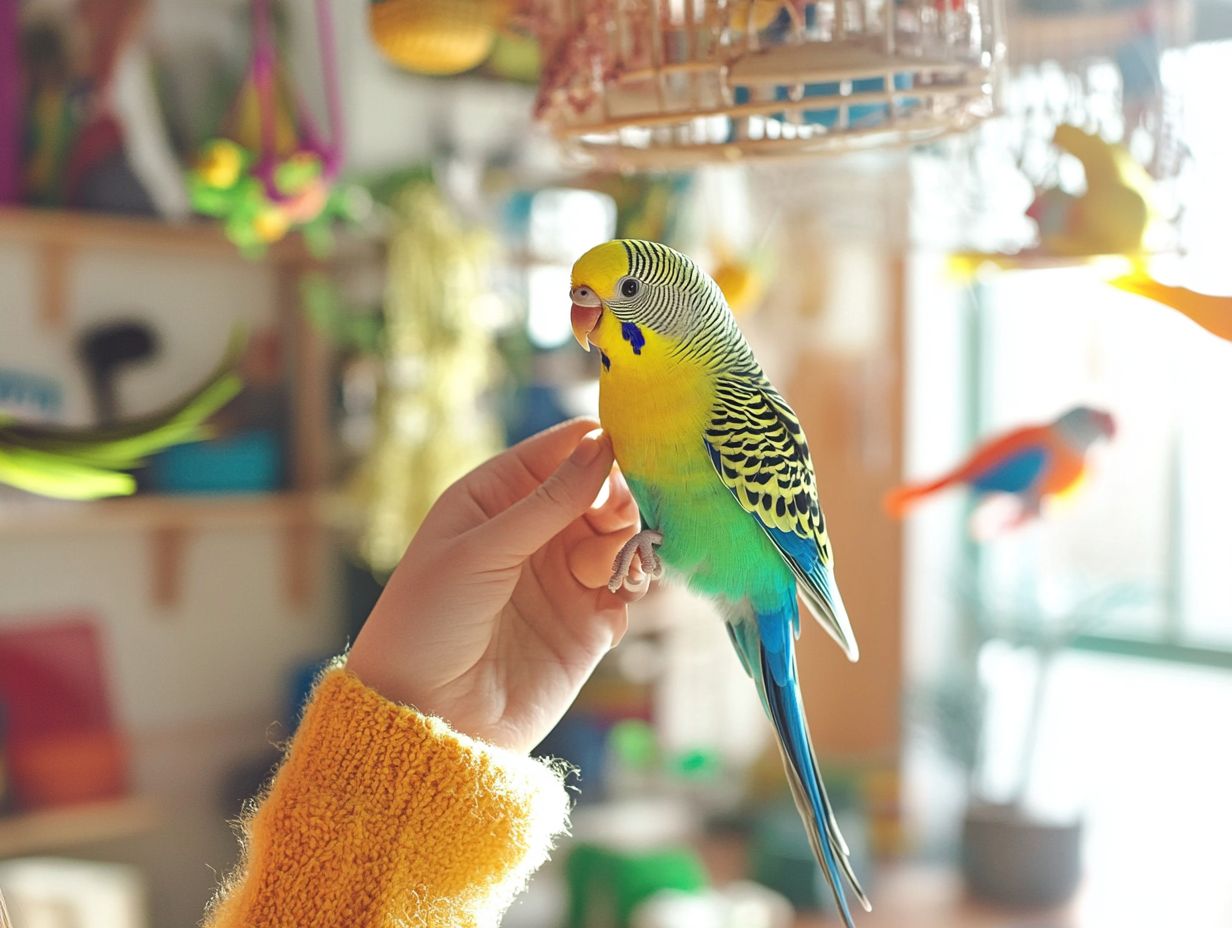
- Choose a bird species known for talking, such as parrots or cockatiels, and consider factors like age and personality when selecting your bird.
- Use positive reinforcement and consistent training techniques, such as repetition and praise, to teach your bird to talk.
- To maintain your bird’s talking abilities, continue to reinforce their training and troubleshoot any common issues that may arise, such as distractions or health concerns.
Understanding Bird Sounds
Understanding bird sounds is key for every bird owner! Your feathered friend uses sounds not just to chat with you, but also to convey their needs, feelings, and social dynamics within their surroundings.
Different species, like African grey parrots, Amazon parrots, and Budgerigars, each have their own distinctive calls and talking abilities that can elevate your experience. By recognizing these sounds, you can nurture a more affectionate relationship with your avian companion, paving the way for positive behaviors and emotional well-being.
Why Birds Talk
Birds communicate as a way to connect with their surroundings and their owners, showcasing their intelligence and social nature.
This instinct to engage is especially pronounced in species like African grey parrots and Amazon parrots, which flourish in interactive environments where bonds with humans can be forged. Their talent for mimicking sounds, including human language, goes beyond mere entertainment; it fulfills a vital social role.
By echoing words and phrases, these parrots garner positive reinforcement, enhancing their learning journey. Over time, they cultivate an impressive vocabulary that reflects their cognitive skills and longing for companionship.
The vibrant exchange of attention from their owners enriches this communication, transforming their mimicry into significant interactions that allow them to articulate their place within their social circle.
Types of Bird Sounds
Bird sounds can be intriguingly categorized into various types, from high-pitched calls to intricate phrases and unique sounds that vary among species. Each of these categories plays a crucial role in the avian world.
Take songbirds, for instance. The common nightingale employs melodious phrases primarily to attract mates during the breeding season, showcasing its fitness and genetic quality. In contrast, birds like the American robins produce sharp alarm calls to warn their flock of impending danger, effectively alerting them to nearby predators.
Even domesticated birds, such as budgerigars, develop distinct sounds to communicate with their owners, indicating a bond that transcends mere coexistence. Observing these sounds offers valuable insights into avian behavior and social interactions, making it an endlessly fascinating field of study.
Choosing the Right Bird for Talking
Selecting the perfect talking bird requires thoughtful deliberation on several factors, including the species innate abilities and your dedication to training.
Renowned for their exceptional talking skills, African grey parrots and Amazon parrots stand out. However, effective communication goes beyond mere genetics; it hinges on cultivating a strong bond and fostering trust between you and your feathered companion.
To cultivate a harmonious relationship, your pet care routines must cater to the bird’s specific needs. Thus, it is crucial for prospective owners to grasp what it takes to nurture and encourage talking in these remarkable creatures.
What would you love to hear your bird say?
Start your journey to connect with your feathered friend today!
Best Bird Species for Talking
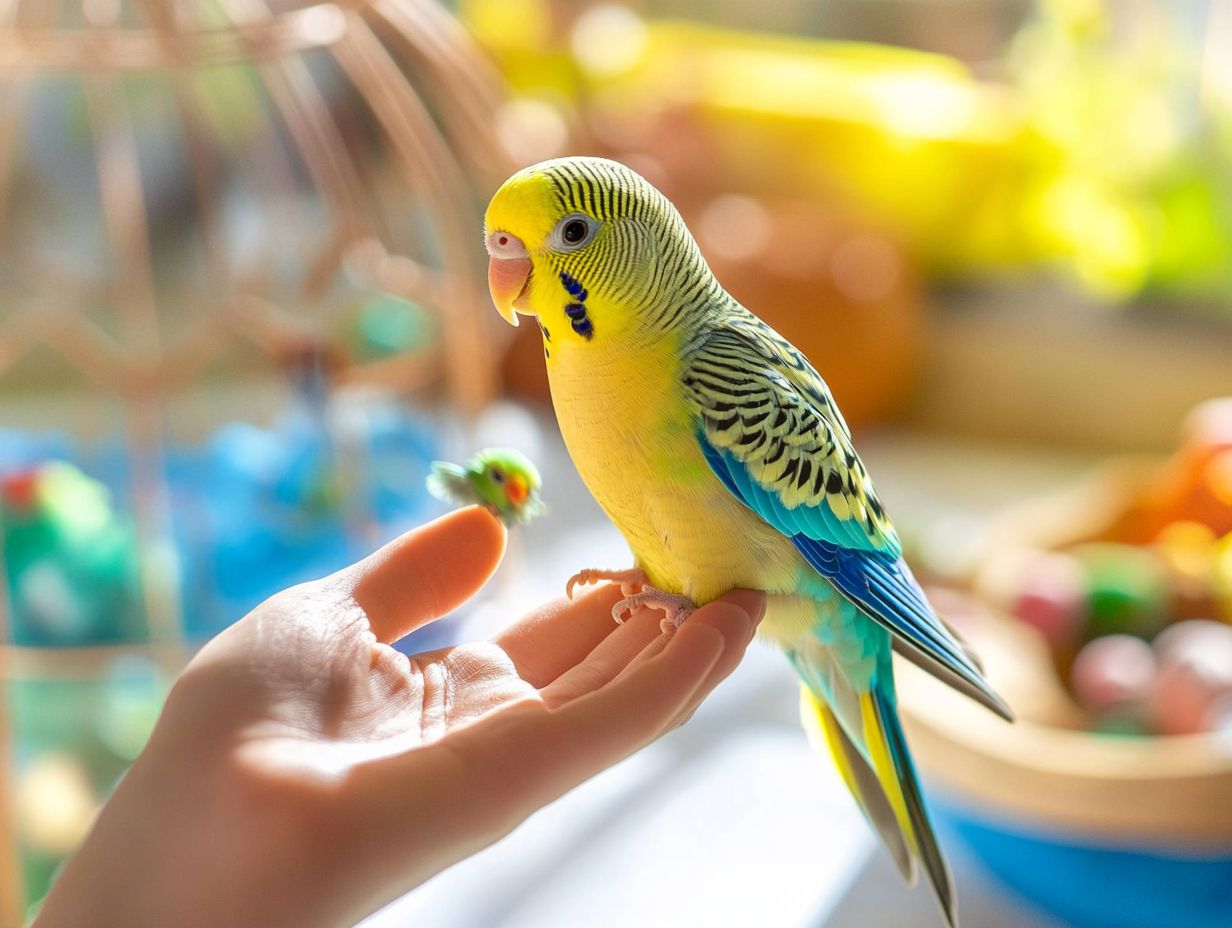
The finest bird species for talking include African grey parrots, Amazon parrots, and parakeets, each celebrated for their extraordinary vocalization skills.
These remarkable birds do more than just mimic human speech; they display an impressive array of sounds, showcasing their exceptional vocal talents. Take the African grey parrot, for example. It stands out with advanced understanding, allowing it to form contextual sentences that can truly amaze you.
Amazon parrots have playful personalities and can imitate a variety of tones, creating lively conversations that keep the atmosphere vibrant.
Parakeets add their charm with sweet, melodious voices, engaging in chirpy dialogues that can effortlessly brighten any home.
Each of these species showcases the captivating relationship between avian intelligence and communication, reminding us that these birds are certainly more than just beautiful feathers.
Factors to Consider When Choosing a Bird
When selecting a bird, it s crucial to consider various factors, such as the time you can dedicate to training, the bird s health, and its ability to communicate effectively within your environment.
Individual breed traits significantly influence which species aligns best with your unique lifestyle and expectations. For instance, some breeds are known for their remarkable vocal talents, while others might be better suited for quieter living spaces.
Assessing how well a bird fits into your daily routine is essential for joyful companionship; energetic birds thrive on interaction and mental stimulation, while certain breeds prefer a more independent existence.
Establishing a healthy environment that mirrors their natural habitat is essential for nurturing their well-being and promoting vocalization. This not only enhances the experience for both you and your feathered companion.
Teaching Your Bird to Talk
Teaching your bird to talk is an enriching journey that calls for consistent practice, positive reinforcement, and learning how to teach your bird tricks while introducing vocabulary and phrases that truly resonate with your feathered companion.
Basic Training Techniques
Basic training techniques for teaching your bird to talk hinge on consistent practice and your attentive involvement. To enhance your approach, consider following guidelines on how to train your bird to talk clearly using methods that foster effective communication.
Establishing a daily routine is essential, as it provides a structured environment that allows your bird to feel secure and open to learning.
Engaging in interactive sessions where you offer vocal rewards for mimicry can significantly strengthen the bond between you and your feathered companion. Incorporating games or songs that your bird enjoys makes the lessons vibrant and enjoyable.
Varying the words and phrases you teach is key to keeping your bird’s interest; too much repetition can quickly lead to boredom. Maintaining a cheerful and encouraging atmosphere helps motivate your bird, reinforcing the notion that communication is not only enjoyable but also rewarding.
Advanced Training Techniques
Advanced training techniques for birds emphasize the importance of building trust and enhancing communication. By introducing complex phrases and using rewards effectively, you can create a more engaging training experience.
To foster a deeper bond with your feathered companion, engage in fun activities like gentle petting or playful interactions. These moments help your bird feel secure and more receptive to learning.
Imagine teaching your bird to say delightful phrases like “Who’s a pretty bird?” or “Come here!” not only does this enrich their vocabulary, but it also solidifies your relationship.
Creating a positive learning environment is crucial. Soft music, consistent routines, and a calm demeanor can significantly enhance the training process. By incorporating these advanced methods, you can encourage your bird to respond enthusiastically, transforming the experience into a joyful adventure for both of you.
Maintaining Your Bird’s Talking Abilities
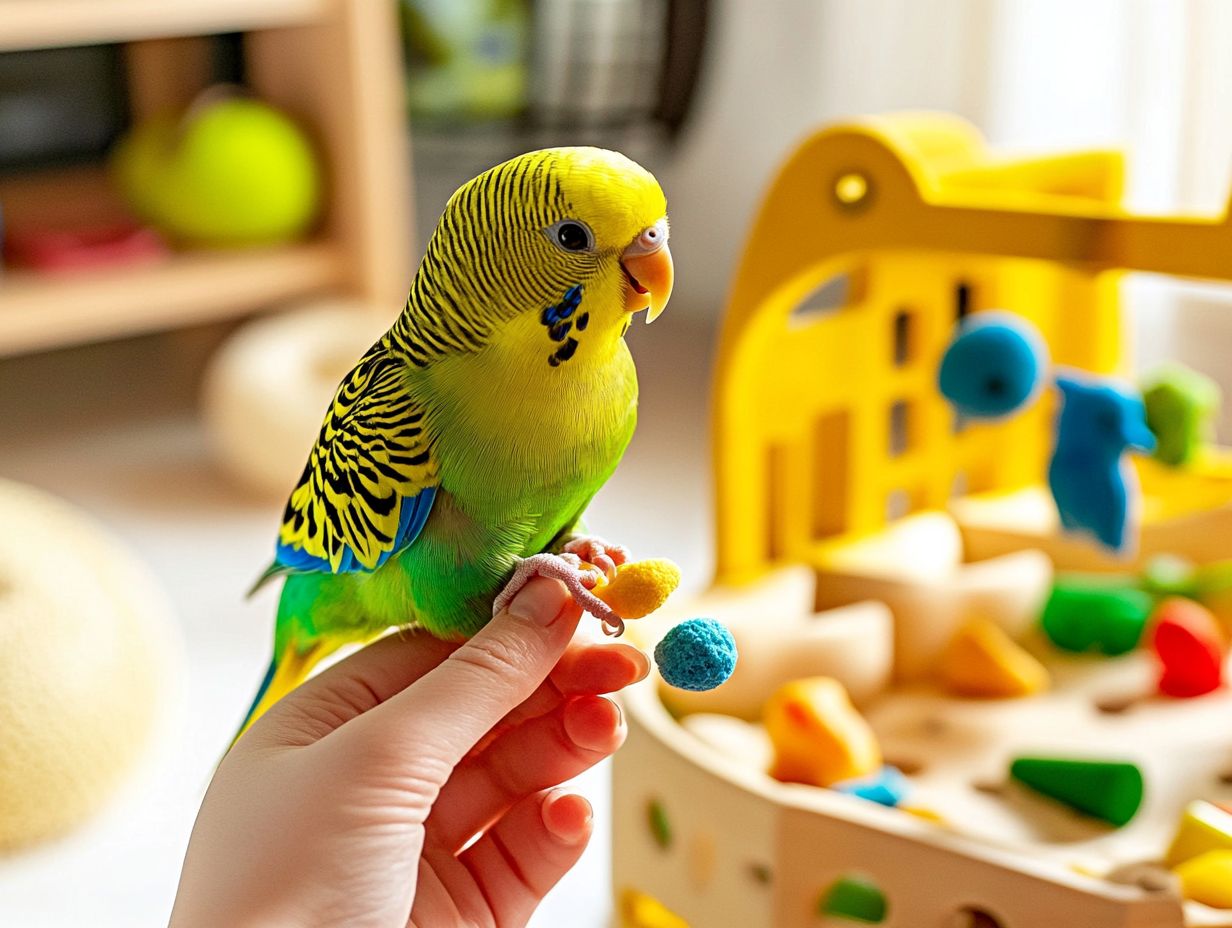
To keep your bird’s talking abilities sharp, consistency in training is crucial. By using positive rewards and engaging in regular interaction, you can effectively teach your pet. For more detailed methods, check out how to teach your bird to mimic sounds. This approach will maintain their skills and enthusiasm.
Consistency and Reinforcement
Consistency and rewards are vital for ensuring your bird retains its talking abilities and shows good behavior during training.
To effectively maintain these skills, establish a regular schedule with daily sessions dedicated to speaking exercises. This structured approach creates a learning-friendly environment and helps your bird associate specific times with training.
When your bird mimics phrases, use positive reinforcement techniques like offering treats or verbal praise. This significantly boosts motivation.
For instance, after your bird repeats a word, follow it up with a favorite snack. This solidifies the behavior and makes learning enjoyable.
Over time, these methods will enhance communication, strengthening the bond between you and your bird. Your relationship will become more affectionate.
Troubleshooting Common Issues
When troubleshooting your bird’s talking abilities, pinpointing changes in actions, health issues, and the nature of your interactions is essential.
Stressors like sudden environmental changes, loud noises, or shifts in your household routine can negatively impact your feathered friend s vocalization. Also, health problems such as respiratory infections or a poor diet can hinder speaking skills.
To tackle these issues, create a stable and enriching environment where your bird feels safe. Regular veterinary check-ups are crucial for identifying any underlying health issues.
Ongoing interaction is important. Engage in daily conversations, mimic songs, and encourage socialization. These activities stimulate your bird s mind and encourage more vocalization, essential for effective communication.
Frequently Asked Questions
What is the best way to train my bird to talk?
Did you know that the best way to train your parrot to talk is through repetition and positive rewards? Spend time talking to your bird daily and reward it with treats when it mimics words or sounds. This ensures a rewarding training experience.
Can all birds be trained to talk?
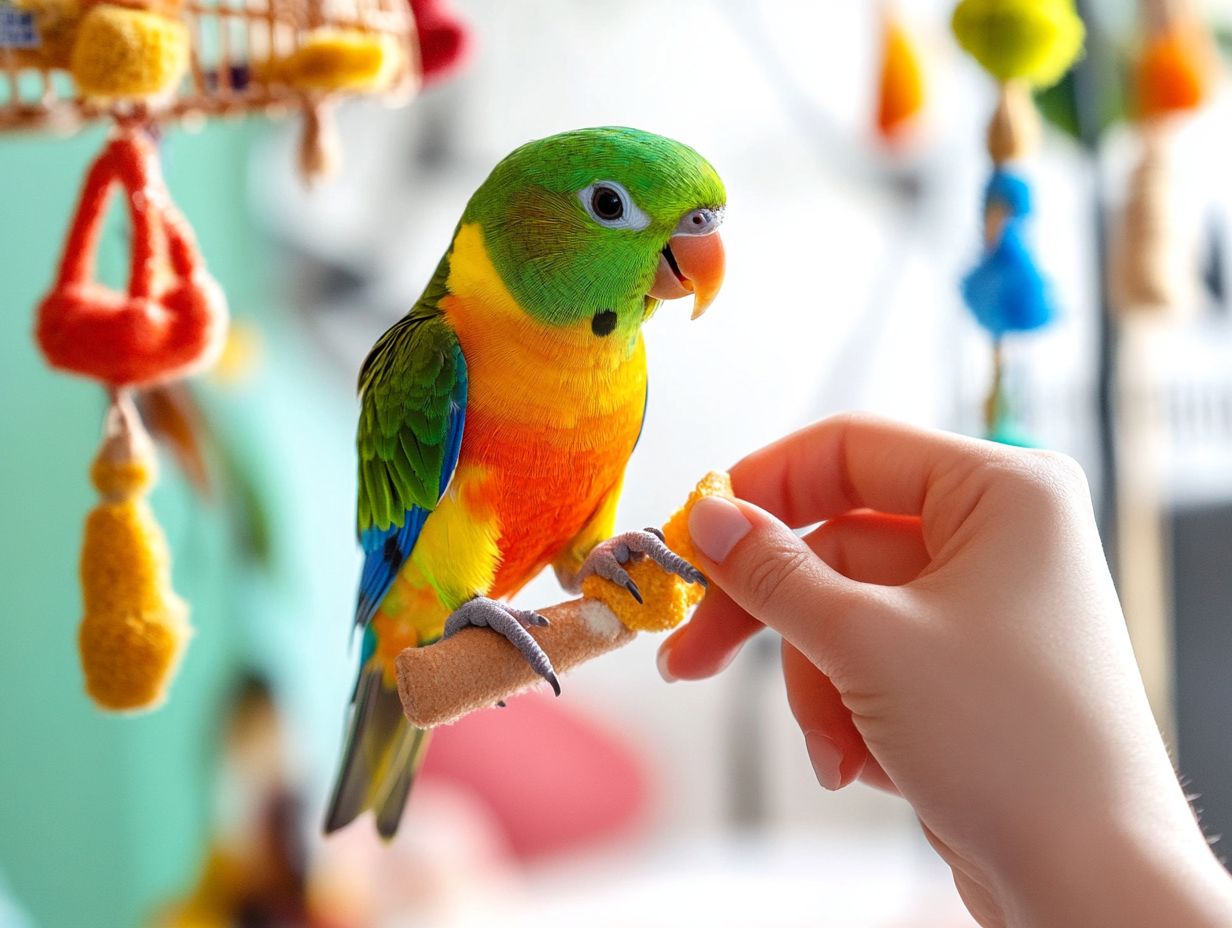
While certain birds are more likely to talk, all have the potential to learn. It may take more time and effort with specific species, like parakeets and Budgerigars, but with patience and consistency, most birds can be trained to talk.
How long does it take to train a bird to talk?
The time it takes to train a bird to talk varies. Some may start mimicking words within weeks, while others might take several months. It ultimately depends on the bird s learning ability, species, and the time dedicated to training.
Is it important to start training my bird to talk at a young age?
Starting training at a young age can be beneficial, especially for species like Eclectus and Long-billed Corellas. However, it s not necessary. Birds of all ages can learn to talk, so don t worry if you didn t start when they were young.
What are some tips for teaching my bird to talk?
Some effective tips include using short and simple words, speaking in a clear tone, and providing lots of praise and treats for good behavior. It’s crucial to be patient and not get frustrated if your bird doesn t pick up words immediately, as the training process can vary.
Can I teach my bird to talk if it’s already an adult?
Yes! You can still teach an adult bird to talk. It may take more time and effort, but with consistency and patience, including regular training sessions and interaction, most birds can learn to talk at any age.
Start your training sessions today, and watch your feathery friend flourish!
